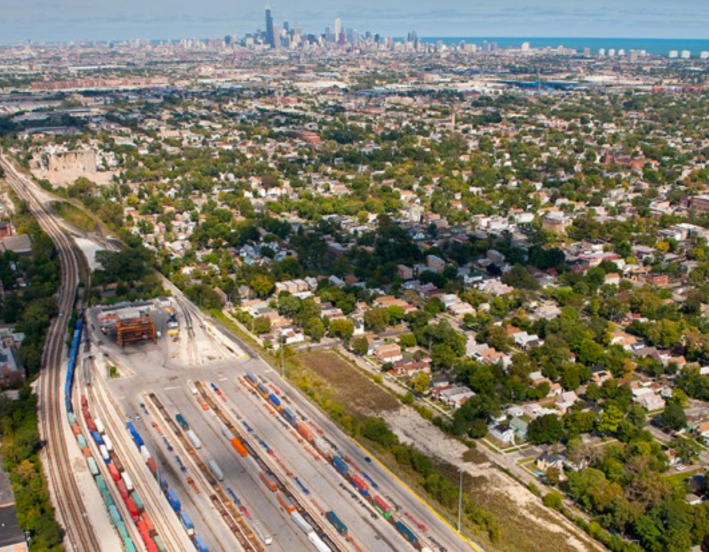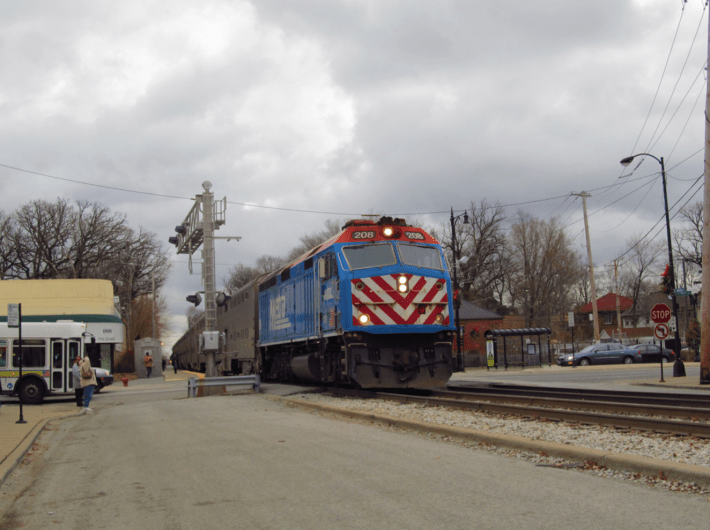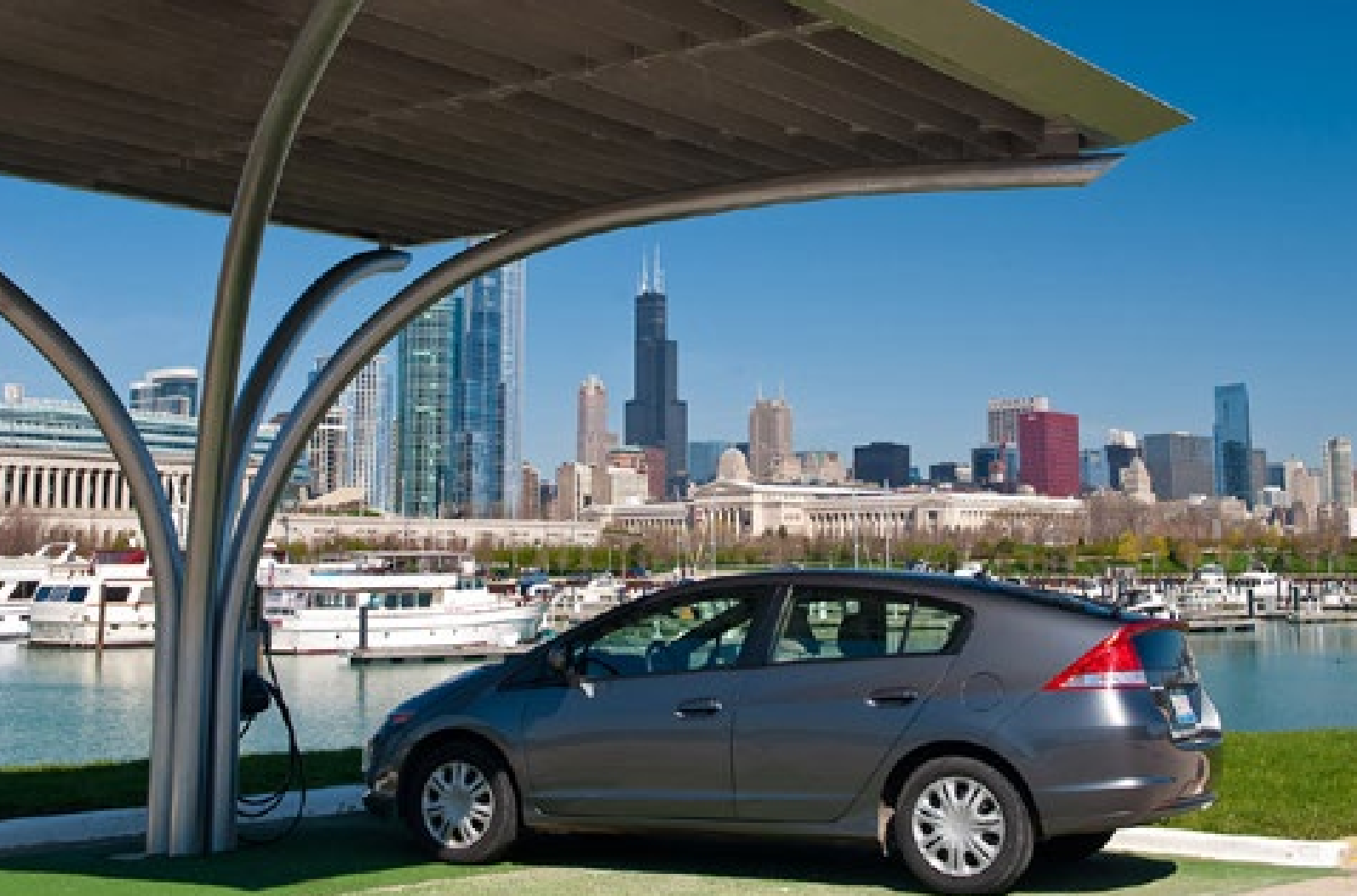Last week the Rahm Emanuel-appointed Transportation and Mobility Task Force, headed by former U.S. transportation chief Ray LaHood, released its “Roadmap for the Future of Transportation and Mobility in Chicago.” The goal of the report is to get in front of upcoming policy challenges as ride-share, shared mobility devices, and autonomous and electric vehicles, and other new technology become more prevalent.
The task force includes a who’s who of local transportation heavy-hitters, including city agency heads, transit officials, and representatives of transportation planning and advocacy organizations. The resulting study makes a number of worthwhile statements about improving accessibility, in terms of both making transit affordable and making it usable by people with disabilities. And I do appreciate its forward-thinking vision and push to experiment.
Yet, in other respects, the report is limited. It focuses on assets and variables the city controls. While there is something to be said for zeroing in on what Chicago can do by itself, the report misses some opportunities to capitalize on major regional transit assets and collaborate with other transit providers to make them work better for Chicagoans.
As the report’s executive summary explains, the task force set out to identify ways to make Chicago public and private transportation safe, accessible, equitable, affordable and non-discriminatory for all riders. It also emphasizes that residents should have choices when it comes to getting around, but that private transportation providers should be regulated with an eye to the public’s best interests. It notes that data should be shared between providers and the city in a way that is both “transparent” and “secure,” and transportation improvements should help make the city both inclusive and innovative.
One of the report's major concerns is funding, both to cover operating expenses and to address the growing backlog of deferred infrastructure projects. It recommends both increasing the state gas tax, (something Emanuel called for in December) and looking into implementing other taxes to bolster revenue. The report notes that even if the gas tax is raised, it will likely become a less significant revenue source as hybrid and electric vehicles become more prevalent, so it’s prudent to explore other funding alternatives, such as mileage-based road user fees.
The task force’s other major concern is the rising number of cars on the road. The report acknowledges that much of that increase was driven by the growing popularity of ride-share. To help reduce congestion, it recommends incentivizing “multi-passenger rides” and public transit while discouraging single-occupant rides and cruising by ride-share drivers. But, at the same time, the report recommends encouraging taxi companies and ride-sharing services to expand their service to underserved areas of the city, as well as encouraging ride-sharing firms to provide options for using their service without a mobile device or credit card.
In some ways, the above two goals are at cross-purposes. While we want people in low-income and outlying neighborhoods to have better access to ride-share, that would likely result in more cars on the road. And, as I learned firsthand while covering the West Side for the Austin Weekly News, traffic jams aren't just something that exist in affluent or centrally located neighborhoods. That said, the report also recommends looking at the current commuting patterns from low-income neighborhoods and seeing if bus routes can be adjusted to better accommodate them.
The report also recommends addressing the issue of taxis and ride-sharing drivers slowing down traffic when they pick up and drop off passengers. It recommends piloting “separate locations for drop-off and pick-up in high congestion areas, which would reduce usage of bus lanes, bus stops, taxi spaces, and delivery locations.” Cab companies and ride-share service would be required to use geo-fencing to prevent drivers from dropping off in restricted areas.
To further reduce congestion, the report recommends that the city continue to work with employers to not only encourage their employees to use transit, but to discourage them from driving into the city.
The report isn't especially ambitious when it comes to new infrastructure investments, simply recommending that the city stay the course with its current plans for the south Red Line extension, the Red and Purple Modernization project on the North Side, and the new Damen/Lake Green Line 'L' station, as well as moving forward with the CREATE program to reduce freight rail congestion.

The study does recommend making all 'L' stations Americans With Disabilities Act-compliant (again, something that the CTA is already doing, although their deadline isn’t until 2038.) It also proposes improving facilitating CTA bus boarding at key stops by adding Loop Link-style raised boarding platforms, accessible from the sidewalk via ramps. In addition to helping people with mobility challenges, this would make boarding easier for passengers with strollers and large luggage.
Speaking of ADA compliance, the report recommends using financial incentives to encourage taxi and ride-share companies to make their vehicles wheelchair-accessible. While visiting Pace's new paratransit HQ last year, I learned that, although the transit agency works with cab firms to supplement its paratransit service, it can't do the same with ride-share because companies like Uber don't necessarily comply with federal reporting and employee background check requirements. Unless the ride-share companies address that issue, it could also be a barrier to offering fin incentives to the companies to improve accessibility.
One of the more concrete recommendations in the report is for the city and CTA to lobby for a state law legalizing the use of automated enforcement to enforce bus-only lanes. (Mayoral hopeful Lori Lightfoot says she is in favor of this; Toni Preckwinkle is opposed.) The report emphasized that such legislation should “ensure that penalties are fair and reasonably applied” and that the money from the fines would go toward enhancing transportation infrastructure, especially public transit.
The report also recommends that the city encourage the use of electric vehicles, both by city agencies and residents. That includes electrifying the CTA and city's fleets. So far, progress in this area has been slow. As I've written before, Pace has two diesel-electric buses, but it never bought more of them because the cost of the vehicles and charging stations outweighed the fuel savings.
The report does recommend that the CTA pursue “various funding opportunities, including Federal Congestion Mitigation and Air Quality Program dollars,” as well as looking at replacing older vehicles that are taken out of service with electric ones. As for encouraging private electric vehicle use, the report recommends looking into whether the city can team up with the private sector to build charging stations. It also floats the idea of adding zoning requirements for charging stations at new developments, and offering financial incentives to owners of existing buildings to add stations.
As for recommendations for cycling and shared-mobility devices, some of the more notable proposals include having the city run “modest pilot of scooter-sharing in 2019,” as well as requiring scooter and bike-share companies to offer options for unbanked Chicagoans and folks with disabilities.
The report also calls for more bike/ped infrastructure improvements such as curb extensions, pedestrian islands, and protected bike lanes. But it doesn’t set any mileage goals for bikeway expansion. (Both candidates have pledged to build 100 more miles of bike lanes, including 50 miles of protected lanes.)
Finally, looking to the future, the report recommends that the city implement a connected and autonomous vehicles pilot.
But I couldn’t help but notice what isn't in the report. It goes to great lengths to talk about the importance of collaboration between various city departments, transit providers and transportation planning organizations. But it is virtually silent on ways CTA and other city agencies could work together with Metra, Pace and the South Shore Line to improve transit in the areas those agencies serve.
The report does note that Pace operates paratransit services within the city and that Metra has 77 stations within the city limits. But, as Streetsblog has previously reported, the Metra Electric line's South Chicago branch lies entirely within city limits, its main branch serves Hyde Park and most neighborhoods further south, and its Blue Island branch is mostly located on the city's southern edge.

Metra’s Rock Island line provides service to the Beverly and Morgan Park neighborhoods, with stations within those neighborhoods spaced closer together than anywhere else in the system. And those are just the most obvious examples of neighborhoods that have no 'L' service, but where Metra provides quick and direct access to the Loop. However, Metra’s utility for Chicagoans is limited due to relatively infrequent service and zone-based fares that are more expensive than riding the CTA.
While Pace doesn't have as much of a presence in Chicago as Metra, there is plenty of service overlap in the city's outlying neighborhoods. To give some of the more obvious examples, Route 270 provides the only transit service along the portion of Milwaukee Avenue north of Jefferson Park Transit Center; Route 349 provides the only transit service on the portion of Western Avenue that runs through Morgan Park and the section of Beverly south of 95th Street; and Route 331 provides the only service along the portion of Cumberland Avenue within O'Hare community area, between Lawrence and Belmont avenues. And as I've previously written in my transit tips and tricks piece, most of Pace's UPS shuttles originate in Chicago, providing the only late night service of any kind in several West Side and South Side neighborhoods.
The South Shore Line primarily serves northern Indiana, but it is also the only rail service in the Hegewisch neighborhood on Chicago’s southeastern corner, providing a direct connection to Hyde Park and the Loop.
It could be argued that the lack of discussion of collaboration between the city of Chicago / CTA and Metra, Pace, and the South Shore Line simply reflects the reality that Chicago doesn't have much sway over the other transit agencies. The mayor of Chicago only gets to appoint one Metra board member and one Pace board member. And since the South Shore Line is run by the Northern Indiana Commuter Transportation District, it has no Chicago representation at all.
But it isn't as if collaboration between transit agencies is impossible. Pace and CTA, for example, are currently working on the North Shore Coordination Plan to restructure their services in the northern suburbs. This restructuring will also lead to several CTA routes currently serving the suburbs being replaced with Pace routes. And there is an (admittedly long-stalled) project to add a Metra station in Edgewater.
Still, we’ve only scratched the surface of what collaboration between the transit agencies can do to improve mobility for residents. So it’s a shame that the transportation and mobility task force missed an opportunity to help improve that situation.
![]()
Did you appreciate this post? Consider making a donation through our PublicGood site.






